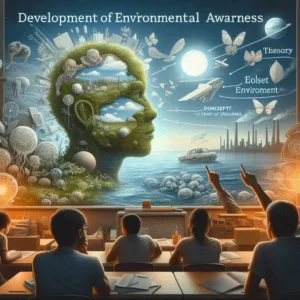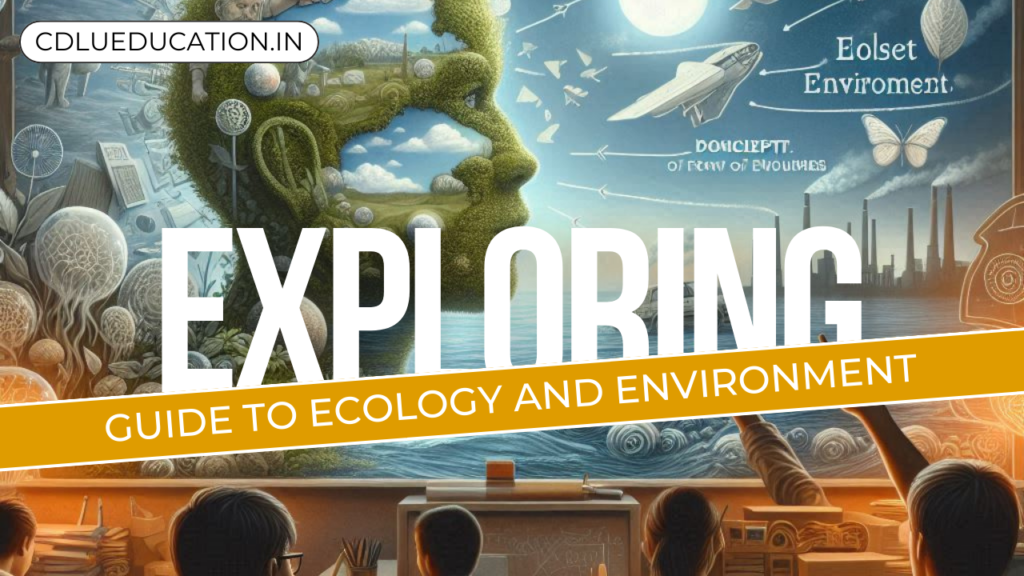Ecology and Environment
Introduction
In the field of biology, the terms ecology and environment are often intertwined, yet they have different scopes and significance. Environment includes all the conditions that influence the development and sustainability of life on Earth, forming the immediate surroundings for organisms to live and function. Ecology, on the other hand, delves deeper into the complex relationships among organisms and their interactions with both the physical and biological environments. This article presents a detailed exploration of these concepts, elucidating their importance and interdependencies.

Key Concepts in Ecology
Understanding Ecology
Ecology is the scientific study of the interactions between living organisms and their physical and biological environments. Coined by Ernst Haeckel and significantly developed by Eugene Odum, ecology provides a framework for understanding the dynamic relationships within ecosystems.
Branches of Ecology
Ontology: focuses on individual species and their adaptations to the environment.
Synecology: studies groups of species within communities, including aquatic and terrestrial ecology.
Applied ecology: Addresses conservation efforts and the economic benefits of organisms.
Geneology: Examines genetic variation within species relative to environmental factors.
Systems ecology: Uses mathematical and computational tools to analyze ecosystem structures and functions.
Ecological hierarchy
The ecological hierarchy is structured from the simplest to the most complex levels:
Organism: The fundamental unit of ecology, consisting of all living beings.
Species (population): Groups of organisms that are capable of interbreeding and producing fertile offspring.
Biotic community: Interacting groups of different species in a shared environment.
Ecosystem: Functional units consisting of biotic communities and their abiotic surroundings.
Biome: Large geographic regions characterized by distinctive climatic conditions and communities.
Biosphere: The global sum of all ecosystems, representing the domain of life on Earth.
Ecosystem dynamics
An ecosystem includes both biotic components (producers, consumers, decomposers) and abiotic components (climate, soil, water, air). These elements interact through energy flow and nutrient cycles, maintaining the balance and sustainability of life.
Biotic Components
Producers: Autotrophic organisms (e.g., plants) that convert solar energy into chemical energy through photosynthesis.
Consumers: Heterotrophic organisms that depend on producers and other consumers for energy.
Decomposers: Organisms that decompose dead matter, recycling nutrients back into the ecosystem.
Abiotic Components
Climatic factors: Temperature, rainfall, and other weather conditions.
Soil factors: Soil structure, pH, and mineral content.
Hydrological factors: Water availability and quality.

Abiotic Factors Influencing Life
Temperature
Temperature is an important ecological factor, affecting enzymatic activities and metabolic rates. Organisms adapt to different temperature ranges through physiological and behavioral mechanisms.
Eurothermals: Organisms able to tolerate a wide range of temperatures.
Stenothermal: organisms restricted to narrow temperature ranges.
Water
Water is indispensable for life, which affects the survival and distribution of organisms. The salinity and pH of water bodies vary, requiring adaptations in aquatic organisms.
Euryhaline: species that can tolerate a wide range of salinities.
Stenohaline: species restricted to specific salinity levels.
Light
Sunlight drives photosynthesis, the fundamental process of energy production in ecosystems. The quality and intensity of light affect plant growth and animal behavior.
Soil
Soil properties vary geographically, affecting the types of vegetation and animal life supported. Soil structure, fertility, and moisture content are important determinants of habitat suitability.
Biological Interactions
Organisms in ecosystems engage in a variety of interactions that shape community structure and dynamics.
Types of Biological Interactions
Commensalism: one species benefits while the other is unaffected (for example, cattle herons and livestock).
Amensalism: one species is harmed while the other is unaffected (for example, antibiotic-producing fungi and bacteria).
Mutualism: both species benefit from the interaction (for example, bees and flowering plants).
Competition: species compete for limited resources, affecting their fitness and survival.
Predation: a predator hunts and consumes its prey, affecting population dynamics.
Parasitism: a parasite benefits at the expense of its host, which may be harmed or remain unaffected.
Responses to Environmental Stress
Organisms use various strategies to cope with environmental stresses, ensuring survival and reproductive success.
Mechanisms of Adaptation
Regulation: Homeotherms maintain constant internal conditions despite external fluctuations (e.g., thermoregulation in mammals).
Structuration: Internal conditions of poikilotherms vary with the external environment (e.g., reptiles).
Migration: Temporarily moving to a more favorable environment (e.g., migratory birds).
Suspension: Entering a dormant state to avoid extreme conditions (e.g., hibernation in bears).
Notable Adaptations
Kangaroo rat: Obtains water from fat metabolism and minimizes water loss through concentrated urine.
Desert plants: Adaptations such as thick cuticle, sunken stomata, and CAM photosynthesis reduce water loss.
Allen’s Rule: Mammals in cold regions have shorter limbs and ears to reduce heat loss.
Seals: Have a thick layer of fat for insulation.
Himalayan tribes: Exhibit increased red blood cell count to enhance oxygen transport at high altitudes.
Conclusion
Understanding the complex relationships within ecosystems and the influence of environmental factors is important for the conservation of biodiversity and the sustainability of life on Earth. As human activities continue to impact the natural environment, ecological awareness and proactive measures become increasingly important.







Pingback: Development of Environmental Awareness : Definition, Need, Concept and Society of Environment - CDLU Education